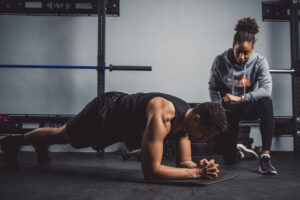When we think about training for strength and aesthetics, most people focus on the larger, more prominent muscle groups like the chest, back, or legs. While these areas are certainly important, there’s one body part that is often neglected but plays a critical role in both daily function and athletic performance: the forearms.
A strong set of forearms not only improves your grip strength but also enhances your overall power and endurance in various exercises, from deadlifts to pull-ups to even simple tasks like carrying groceries. In this comprehensive guide, we’ll dive deep into the anatomy of the forearm, the benefits of forearm training, and provide a detailed workout plan to help you develop strength, size, and endurance in your forearms.
Why Forearm Training is Important
Forearm training is not just about aesthetics, although well-developed forearms certainly look impressive. The real power of forearm training lies in its functional benefits:
1. Grip Strength
Your grip strength plays a crucial role in almost every pulling movement you perform in the gym. Whether you’re lifting heavy weights, climbing, or simply opening a jar, your grip strength is critical. Strong forearms directly enhance your ability to grip, pull, and hold objects for longer periods. Without proper grip strength, your performance in lifts like deadlifts, rows, and pull-ups will suffer.
2. Injury Prevention
Strengthening your forearms can help reduce the risk of injuries, especially in the wrists and elbows. Many athletes and weightlifters experience conditions like tennis elbow, golfer’s elbow, or wrist pain due to weak forearm muscles. Training these muscles improves joint stability and flexibility, lowering the chance of injury during workouts or sports activities.
3. Enhanced Performance in Compound Lifts
Your forearms assist in many compound movements like bench presses, deadlifts, and squats. For example, a weak grip will limit how much weight you can pull off the ground during a deadlift, even if your back and legs are strong enough to lift more. By increasing forearm strength, you allow yourself to perform better in these compound lifts, which can ultimately help you grow stronger and improve overall muscle mass.
4. Improved Daily Function
In everyday life, we use our forearms and hands in countless activities: carrying shopping bags, typing, driving, cooking, and more. Strengthening the forearms directly translates to better functional fitness, making daily activities easier and more efficient.
Forearm Anatomy: Understanding the Muscles
To design an effective workout program, it’s essential to have a basic understanding of forearm anatomy. The forearm is made up of several muscles that can be divided into two main groups: the flexors and the extensors.
1. Flexors (Anterior Compartment)
These muscles are located on the palm side of your forearm and are responsible for flexing (bending) your wrist and fingers. The main flexor muscles include:
- Flexor Carpi Radialis: Helps in wrist flexion and radial deviation (moving the wrist toward the thumb).
- Flexor Carpi Ulnaris: Assists with wrist flexion and ulnar deviation (moving the wrist toward the pinky finger).
- Flexor Digitorum Superficialis: Flexes the fingers and assists in wrist flexion.
2. Extensors (Posterior Compartment)
The extensor muscles are located on the back (top) side of the forearm and are responsible for extending (straightening) the wrist and fingers. The key extensor muscles include:
- Extensor Carpi Radialis Longus: Assists with wrist extension and radial deviation.
- Extensor Carpi Ulnaris: Helps with wrist extension and ulnar deviation.
- Extensor Digitorum: Extends the fingers and aids in wrist extension.
Additionally, there are smaller muscles, like the brachioradialis, which play a role in elbow flexion, and the pronators and supinators, which rotate the forearm. To fully develop the forearms, it’s crucial to target both the flexor and extensor muscles, as well as focus on grip strength exercises that challenge the entire forearm region.
Types of Grip and Their Importance
Before diving into the workout routine, it’s important to understand the different types of grip and how each one can be targeted to improve overall forearm strength:
1. Crush Grip
The crush grip is what most people think of when they hear “grip strength.” It involves squeezing something with your fingers and thumb, like a dumbbell, barbell, or even a hand gripper. This type of grip is essential for exercises like deadlifts and rows.
2. Pinch Grip
Pinch grip strength is the ability to hold onto something between your fingers and thumb. This grip is often used in functional activities like carrying bags or opening jars, and it can be trained with pinch plates or by holding objects with no handles, such as a smooth weight plate.
3. Support Grip
Support grip is your ability to hold onto an object for an extended period of time. Exercises that test support grip include hanging from a pull-up bar or holding a heavy dumbbell in each hand (farmer’s carry). This grip is vital for endurance in lifting and pulling movements.
4. Wrist Flexion/Extension
Wrist flexion and extension exercises specifically target the muscles that move the wrist up and down. These are commonly trained with wrist curls and reverse wrist curls and are vital for developing both the flexor and extensor muscles in the forearm.
Forearm Workout: Building Strength and Size
Here’s a comprehensive forearm workout that targets both the flexor and extensor muscles, while also improving your grip strength. Perform this routine 2-3 times per week, either on its own or at the end of your upper body workouts.
1. Wrist Curls (3 sets of 12-15 reps)
Wrist curls are one of the most effective exercises for building size and strength in the forearm flexors.
- Sit on a bench with a dumbbell in each hand, palms facing up.
- Rest your forearms on your thighs, allowing your wrists to hang off the edge.
- Slowly curl the dumbbells upward by flexing your wrists, then lower them back down in a controlled motion.
2. Reverse Wrist Curls (3 sets of 12-15 reps)
Reverse wrist curls target the forearm extensors and help create balanced muscle development.
- Sit on a bench with your forearms resting on your thighs, but this time with your palms facing down.
- Hold a light barbell or dumbbell in each hand, and slowly extend your wrists upward, lifting the weight. Lower back down under control.
3. Farmer’s Carry (3 sets, 30-45 seconds)
Farmer’s carries are excellent for improving grip strength and forearm endurance.
- Grab a pair of heavy dumbbells or kettlebells and hold them at your sides.
- Stand tall with your shoulders back and core engaged.
- Walk a set distance or for a set amount of time (30-45 seconds), focusing on keeping a strong grip on the weights.
4. Towel Pull-Ups (3 sets to failure)
Towel pull-ups are a variation of the traditional pull-up that places more emphasis on your grip and forearms.
- Wrap two towels around a pull-up bar and grab one in each hand.
- Perform pull-ups by pulling yourself up until your chin is over the bar, then lower yourself back down under control.
- If pull-ups are too difficult, perform a dead hang (just hang from the towels) for as long as possible.
5. Plate Pinch Hold (3 sets, 20-30 seconds)
This exercise is perfect for improving pinch grip strength.
- Grab two smooth weight plates and pinch them together between your fingers and thumb.
- Hold the plates at your sides for as long as you can (aim for 20-30 seconds).
- If it becomes too easy, increase the weight or use thicker plates.
6. Hammer Curls (3 sets of 10-12 reps)
Hammer curls are a great exercise for the brachioradialis, which is a key forearm muscle involved in elbow flexion.
- Stand with a dumbbell in each hand, palms facing your torso.
- Curl the weights up as you would in a regular bicep curl, but keep your palms facing each other throughout the movement. Lower the weights back down in a controlled motion.
7. Dead Hangs (3 sets, 30-60 seconds)
Dead hangs are an excellent way to build support grip strength.
- Hang from a pull-up bar with both hands, letting your body weight stretch your grip.
- Hold this position for as long as possible, aiming for 30-60 seconds per set.
8. Finger Curls (3 sets of 15-20 reps)
Finger curls target the smaller muscles in your hands and forearms and help improve overall grip strength.
- Hold a barbell or dumbbells with your arms straight down in front of you, palms facing up.
- Curl the bar or dumbbells using only your fingers, letting the weight roll down your fingers slightly before curling it back up.
Advanced Forearm Training Techniques
Once you’ve mastered the basics, you can start incorporating more advanced techniques into your forearm workouts to take your training to the next level.
1. Thick Bar Training
Using a thicker barbell or dumbbell can significantly increase the difficulty of your exercises by forcing your forearms to work harder to maintain a grip. If you don’t have access to thick bars, you can use Fat Gripz or wrap a towel around the bar to achieve a similar effect.
2. Isometric Holds
Isometric holds are an excellent way to build endurance and strength in your forearms. For example, instead of just performing a farmer’s carry, you could try holding the weights in place for a longer period. You can also hold the top position of a pull-up or the contracted position of a wrist curl for added intensity.
3. Drop Sets
To push your forearms to the limit, incorporate drop sets into your routine. After completing a set of wrist curls or reverse wrist curls, immediately reduce the weight by 20-30% and perform another set to failure. This technique increases muscle fatigue and can help promote greater muscle growth.
4. Grip-Specific Tools
There are several grip-specific tools available that can help you develop stronger forearms. For example, hand grippers, wrist rollers, and Captains of Crush grippers are all great for targeting different aspects of your grip strength.
Forearm Training Tips for Maximum Results
Here are some additional tips to help you get the most out of your forearm training:
1. Train Consistently
Like any other muscle group, consistency is key when it comes to forearm development. Aim to train your forearms at least twice per week, either on their own or as part of a larger upper-body workout routine.
2. Focus on Progressive Overload
To continue seeing progress, you need to progressively increase the resistance or intensity of your workouts. This could mean lifting heavier weights, increasing the duration of isometric holds, or adding more reps over time.
3. Incorporate Variety
The forearms are made up of multiple muscles that perform different functions, so it’s important to incorporate a variety of exercises into your routine. Make sure you’re targeting both the flexors and extensors, as well as working on your grip strength from different angles (crush, pinch, support).
4. Don’t Neglect Recovery
Forearm muscles, like all muscles, need time to recover and grow. Make sure you’re giving your forearms adequate rest between training sessions and incorporating proper nutrition to support muscle repair.
Common Mistakes to Avoid
When training your forearms, it’s important to avoid these common mistakes:
1. Overtraining
It’s easy to overtrain your forearms since they’re used in so many exercises. Make sure you’re not overdoing it by giving your forearms enough rest and recovery between workouts.
2. Neglecting the Extensors
Many people focus solely on wrist curls and other flexor exercises, but neglect the extensor muscles. This can lead to imbalances and increase the risk of injury. Be sure to include reverse wrist curls and other extensor-focused movements in your routine.
3. Using Too Much Weight
While it’s important to challenge yourself, using too much weight can compromise your form and increase the risk of injury. Focus on using a weight that allows you to perform each exercise with proper form and control.
Conclusion
Forearm training is an often-overlooked aspect of fitness, but it plays a crucial role in building strength, improving performance, and preventing injury. By incorporating a variety of exercises that target the flexors, extensors, and grip muscles, you can develop strong, muscular forearms that enhance both your athletic performance and daily function.
So, the next time you hit the gym, don’t forget to dedicate some time to your forearms. With consistency, variety, and progressive overload, you’ll see significant improvements in your grip strength, forearm size, and overall strength.
As of 2023, advancements in sports science have introduced new tools and techniques for forearm training. Wearable technology now allows athletes to monitor muscle activation and fatigue in real-time, optimizing workout efficiency. Additionally, virtual reality (VR) training programs have been developed to simulate various grip challenges, providing an innovative way to enhance grip strength and endurance. These technologies are becoming increasingly accessible, offering new dimensions to traditional forearm workouts.








It’s great to see a focus on forearm training, as it’s often overlooked but so vital for both gym performance and everyday tasks. Strengthening your forearms can enhance your grip, prevent injuries, and improve your overall athletic abilities. Keep up the consistency and variety in your workouts, and you’ll definitely notice the benefits!